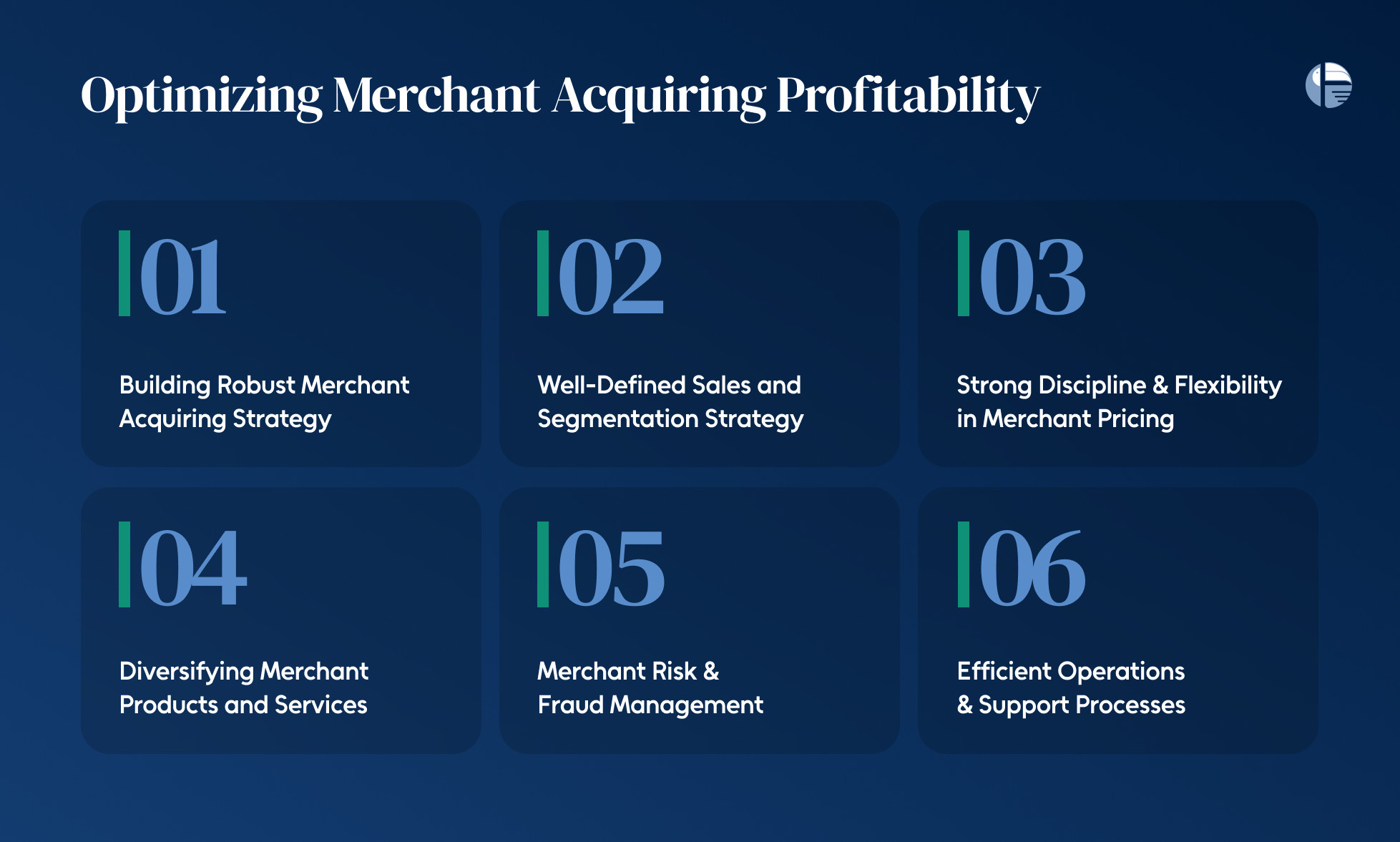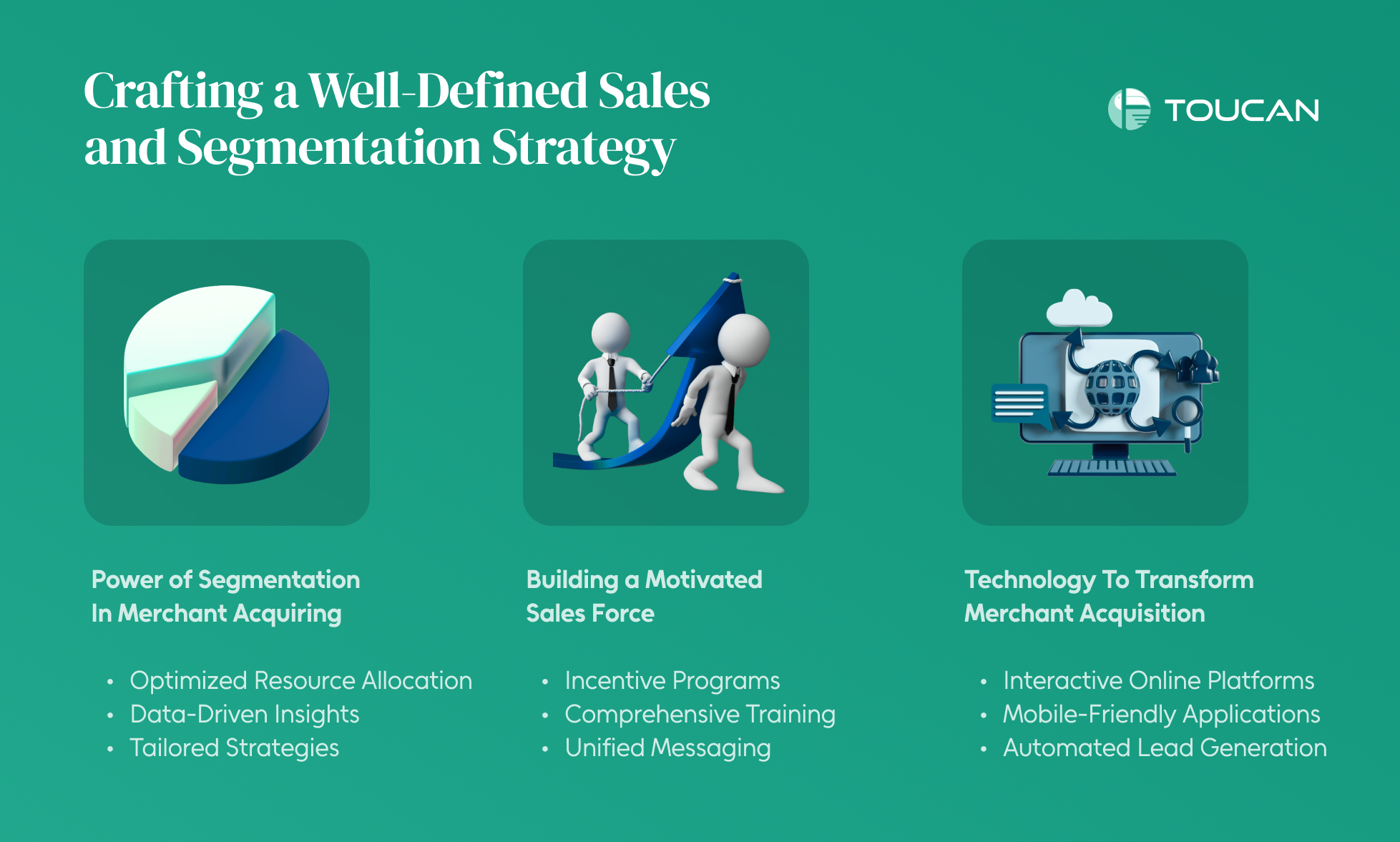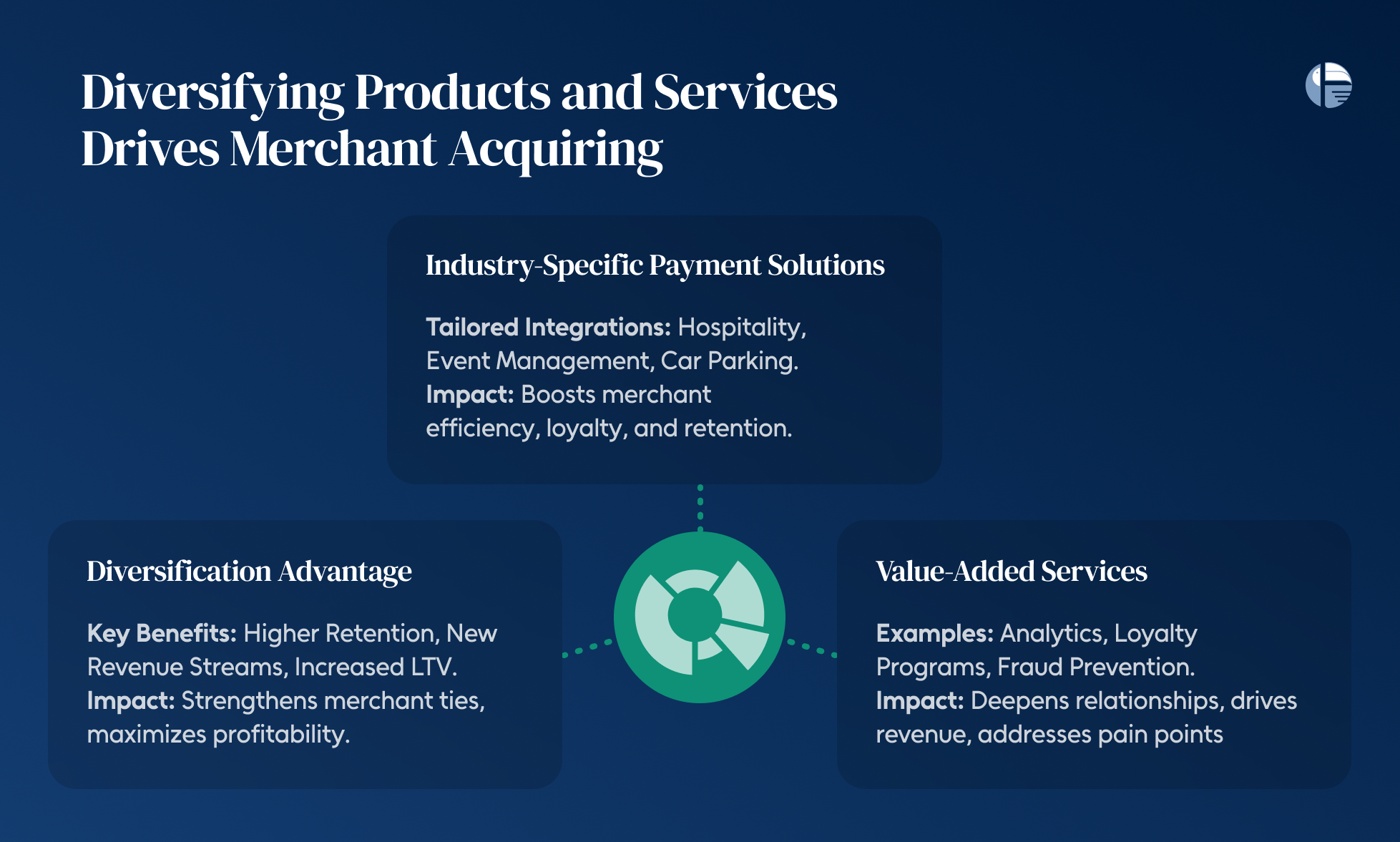Smart Strategies to Maximize Merchant Acquiring Profitability

The merchant acquiring business stands at the crossroads of innovation, strategy, and fierce competition. For acquirers, profitability doesn’t come easy—it requires the ability to navigate a complex landscape while balancing revenue margins, operational costs, and merchant expectations.
In a market often defined by fragmented players and intense price wars, what sets profitable acquirers apart? Here are six key traits that help acquiring businesses thrive while addressing common industry pain points.
Building a Robust Merchant Acquiring Strategy for Business Profitability
- Establishing a Clear Merchant Acquiring Business Strategy
Every successful acquiring business starts with a clear roadmap. This strategy must gain buy-in from senior management and align all departments to ensure cohesive execution.
Key Elements of a Winning Strategy:
- Performance Targets: Set measurable goals such as merchant retention rates, transaction volume growth, and revenue margins. Regularly track performance metrics to identify areas for improvement.
- Product Differentiation: Focus on creating innovative solutions that address merchant pain points, like dynamic currency conversion, fraud protection, and seamless integration with e-commerce platforms.
- Channel Optimization: Leverage all available channels, including digital platforms and physical touchpoints, to cross-sell and up-sell services effectively.
By aligning these elements, acquirers can not only attract a diverse merchant base but also ensure sustainable revenue streams.
- Supporting Structures for Strategic Success
A strong strategy is only as effective as the organizational structure that supports it. Profitable acquirers invest in dedicated teams and robust management systems to drive their merchant acquiring efforts.
How Structure Drives Success
- Dedicated Leadership: Create a Merchant Services Division led by a senior executive responsible for daily operations and profitability. This ensures accountability and quick decision-making.
- Resource Allocation: Assign specialized teams to key areas like merchant onboarding, customer support, and fraud prevention.
- Agility in Execution: Foster a culture of adaptability to respond to market shifts and evolving merchant needs.
With the right structure in place, acquirers can focus on strategic priorities without getting bogged down by operational inefficiencies.
- A Culture of Measurement and Accountability
Measurement is the heartbeat of a profitable acquiring business. Without a disciplined approach to tracking financial performance, acquirers risk missing critical insights that could drive profitability.
Best Practices for Measurement
- P&L Framework: Implement a standalone P&L framework to monitor gross revenues, direct costs, and indirect costs. This ensures a clear view of the business’s financial health.
- Data-Driven Decisions: Use analytics tools to identify high-performing merchants, optimize pricing models, and forecast revenue trends.
- Transparent Reporting: Regularly share performance metrics across teams to foster a culture of accountability.
Crafting a Well-Defined Sales and Segmentation Strategy
- The Power of Segmentation In Merchant Acquiring
Merchant segmentation is more than just categorizing clients; it’s about identifying the most profitable segments and aligning resources strategically.
Why Segmentation is Crucial
- Optimized Resource Allocation: Limited resources mean acquirers must focus on high-value segments. For instance, acquirers can target sectors like government or medical industries, which often provide long-term stability and higher margins.
- Data-Driven Insights: By analyzing Merchant Category Codes (MCCs) and other metrics, acquirers can uncover underserved niches or high-growth opportunities.
- Tailored Strategies: Some acquirers may focus on high-margin merchants with simpler needs, while others may specialize in complex solutions for specific industries like education or healthcare.
- Building a Motivated Sales Force
A motivated and well-informed sales team is critical to acquiring and retaining merchants.
How to Empower Your Sales Team
- Incentive Programs: Implement clear and measurable incentives, both financial and non-financial, to reward sales teams for exceeding targets.
- Comprehensive Training: Equip your salesforce with a deep understanding of merchant acquiring solutions, including product benefits and market-specific use cases.
- Unified Messaging: Ensure all customer-facing staff communicate the value proposition consistently and confidently.
- Using Technology To Transform Merchant Acquisition
Technology is reshaping how acquirers interact with potential and existing merchants. By embracing digital tools, acquirers can streamline processes, reduce costs, and enhance customer experiences.
Innovative Tech Solutions for Sales Growth
-
- Interactive Online Platforms: Sophisticated websites with intuitive workflows enable merchants to apply for services easily, reducing onboarding friction.
- Mobile-Friendly Applications: Sales teams equipped with mobile or tablet-based portals can onboard merchants in real-time, ensuring faster applications and first transactions.
- Automated Lead Generation: Use AI-powered tools to identify and nurture prospective merchants, saving time and increasing efficiency.
Strong Discipline and Flexibility in Merchant Pricing
Merchant pricing, particularly MSF and MDR, directly impacts an acquirer’s financial performance. Striking the right balance between competitive rates and sustainable margins is key.
- Competitive Yet Sustainable MSF/MDR Rates
Acquirers must ensure their pricing aligns with industry standards while safeguarding their revenue streams. Offering rates below cost—such as interchange fees—can be a race to the bottom, eroding profitability.
Best Practice: Analyze market trends to benchmark MSF/MDR rates, ensuring competitiveness without undercutting margins.
- Customizing Pricing Models for Different Merchant Types
- Small Merchants: Many smaller merchants prefer bundled MSF/MDR rates or fixed monthly fees tied to transaction volume. This simplifies reconciliation and reduces administrative burdens.
- Large Merchants: Enterprises often favor unbundled pricing models, where fees are itemized for each card brand or transaction type, offering greater transparency.
Pro Tip: Use data analytics to identify merchant preferences and design pricing structures that resonate with their business models.
- Implementing Effective Transfer Pricing
- Recognize the value merchant acquiring adds to the broader customer relationship.
- Allocate internal costs to the merchant acquiring P&L to reflect the true contribution of these services.
Diversifying Products and Services Drives Merchant Acquiring
- Integrated Payment Solutions for Industry-Specific Needs
Merchants today expect payment solutions tailored to their industry’s unique requirements. Acquirers that integrate their offerings with software solutions designed for specific sectors gain a significant edge.
Examples of Integration Success:
- Hospitality: Seamlessly integrating payment solutions with property management systems.
- Event Management: Partnerships with ticketing software providers to streamline transactions.
- Car Parking: Integration with parking management systems for smooth operations.
The Payoff: Tailored integrations enhance operational efficiency for merchants and foster loyalty, reducing churn.
- Offering Value-Added Services to Deepen Relationships
Acquirers who deliver more than just payment processing create stronger connections with their merchants. Value-added services not only differentiate your offering but also drive incremental revenue.
Popular Value-Added Services Include:
- Analytics and Reporting: Providing merchants with insights into customer behavior, sales trends, and transaction data.
- Loyalty Programs: Enabling merchants to reward customer loyalty and increase repeat business.
- Fraud Prevention Tools: Protecting merchants from potential losses with advanced fraud detection systems.
How It Helps: By addressing key pain points like customer retention and fraud management, these services position acquirers as strategic partners rather than mere service providers.
- The Competitive Advantage of Diversification
Diversifying into integrated solutions and value-added services not only enhances merchant satisfaction but also increases profitability. With more services on offer, acquirers can unlock cross-selling opportunities and gain a larger share of wallet from their merchant clients.
Key Benefits of Diversification:
- Higher Retention Rates: Merchants are less likely to switch providers when multiple aspects of their business rely on your solutions.
- New Revenue Streams: Incremental services provide additional income without significantly increasing operational costs.
- Increased Merchant Lifetime Value (LTV): Stronger relationships lead to longer partnerships and greater profitability over time.
Merchant Risk and Fraud Management
Fraudulent activities and poorly managed risks can wreak havoc on an acquirer’s financial health, from escalating losses to reputational damage. Acquirers must proactively address these challenges with disciplined policies, advanced monitoring, and stringent agent oversight to safeguard their business.
- Establish Robust Risk Management Policies
Having clearly defined and regularly updated policies is the cornerstone of a successful risk management strategy. These policies must align with industry standards and regulatory requirements to ensure compliance and minimize vulnerabilities.
Best Practices for Risk Policies
- Stay Updated: Continuously review and adapt policies to reflect the latest standards set by payment networks and governing bodies.
- Comprehensive Coverage: Include guidelines for merchant onboarding, transaction monitoring, and fraud mitigation.
- Merchant Education: Educate merchants on compliance requirements and the risks associated with fraudulent behavior.
The Impact: A solid policy framework minimizes exposure to financial losses while building trust with merchants and regulators.
- Safeguard Funds with Strategic Reserves and Holdbacks
Properly managing funds is critical to maintaining acquirer profitability. Leading acquirers implement funding controls, such as reserves and holdbacks, to mitigate risks tied to merchant payment acceptance.
Key Approaches to Fund Management
- Settlement Safeguards: Ensure timely and accurate settlements while holding reserves for high-risk merchants.
- Risk-Based Holdbacks: Use dynamic risk models to determine appropriate holdback amounts for merchants with varying risk profiles.
- Transparent Processes: Clearly communicate reserve and holdback policies to merchants to prevent disputes and misunderstandings.
The Impact: Controlled fund management minimizes financial exposure and ensures smooth operations.
- Monitor Merchant and Agent Activities in Real Time
Fraud detection is a continuous process that demands dedicated resources and advanced tools. Monitoring merchant and third-party agent behavior helps acquirers identify anomalies and take proactive measures.
Tools and Techniques for Monitoring
- Data Analytics: Use AI-powered analytics to detect unusual transaction patterns and flag potential fraud.
- Daily Monitoring: Conduct routine checks on merchant and agent activities to identify irregularities.
- Fraud Alerts: Implement automated alerts for transactions that exceed predefined thresholds or exhibit suspicious behavior.
Efficient Operations & Support Processes
Every inefficiency in your acquiring operations can erode profits. From merchant onboarding to customer support, poorly executed processes increase costs, slow growth, and frustrate your merchants. On the other hand, optimized operations enhance profitability by minimizing risk, improving merchant satisfaction, and reducing costs.
- Streamlined Merchant Underwriting and Onboarding
The merchant onboarding process is often the first impression a merchant has of your business. Leading acquirers leverage end-to-end workflows and technology-driven solutions to make onboarding fast and hassle-free.
Best Practices in Merchant Onboarding:
- Customized Risk Assessments: Use tailored processes for different merchant risk levels.
- Technology-Driven Automation: Automate checks and approvals to reduce manual errors and speed up the process.
- Third-Party Integrations: Partner with compliance and risk assessment providers to ensure accurate underwriting.
The Payoff: Faster onboarding reduces churn, enhances merchant satisfaction, and accelerates revenue generation.
- Best-in-Class Merchant Servicing
Great customer service doesn’t just improve satisfaction—it reduces merchant attrition and boosts loyalty. Efficient servicing can significantly cut costs while delivering a seamless experience for your merchants.
Key Elements of Merchant Servicing:
- Comprehensive Training Programs: Equip your support staff with ongoing education to handle queries efficiently.
- Self-Service Portals: Allow merchants to resolve common issues independently, reducing call center dependency.
- Clear Service Level Agreements (SLAs): Define and monitor service standards to ensure consistent quality.
The Payoff: Improved merchant satisfaction leads to higher retention rates and reduced operational costs.
- Seamless Account Settlement and Reconciliation
Managing account settlements and providing clear, timely statements is another critical operational area. The use of outdated methods like paper statements not only increases costs but also slows down reconciliation for merchants.
Steps to Modernize Account Settlement:
- Digital Portals: Enable merchants to access real-time account data online.
- Automated Statements: Deliver account summaries via email or an app, reducing costs and turnaround time.
- Enhanced Reconciliation Tools: Provide tools to help merchants easily match transactions to their records.
Building a Winning Acquiring Business
The path to a profitable acquiring business lies in mastering these six key traits. Whether it’s streamlining operations, offering tailored products, or proactively managing merchant risk, each trait plays a pivotal role in driving growth and sustainability.
By focusing on efficiency, innovation, and merchant-centric strategies, acquirers can not only boost their bottom line but also build lasting relationships in a competitive market. Ready to take your acquiring business to the next level? Start by implementing these proven strategies, and you’ll be well on your way to becoming a market leader.



